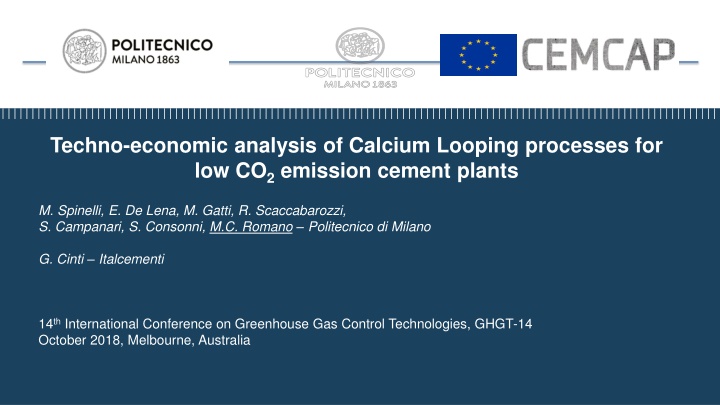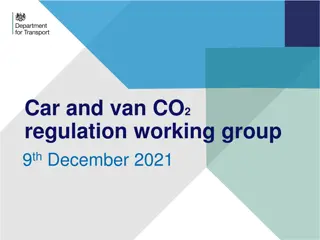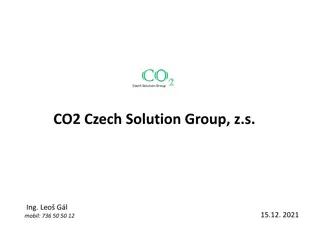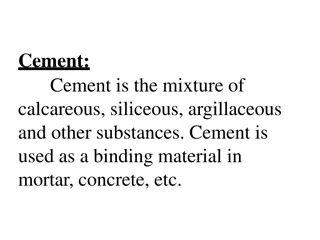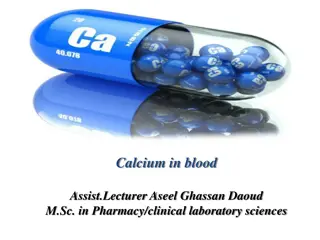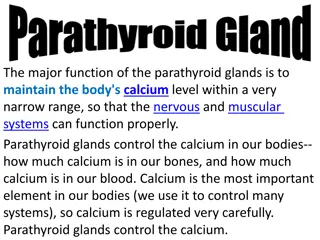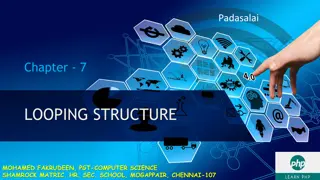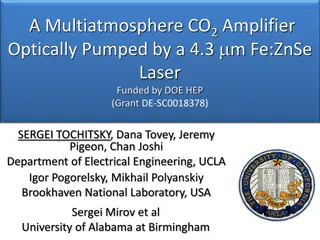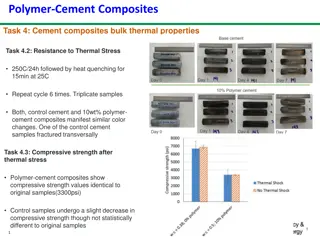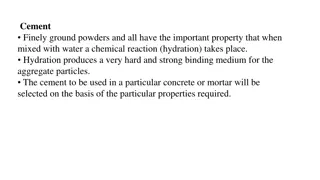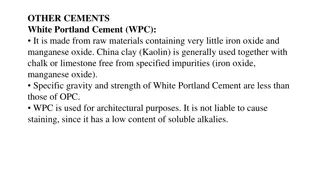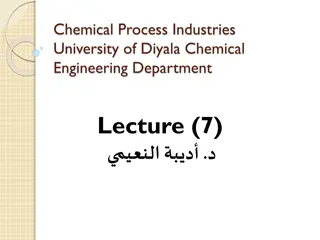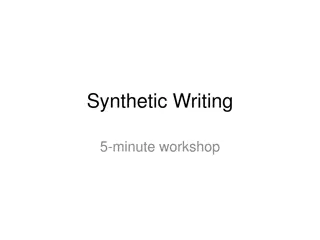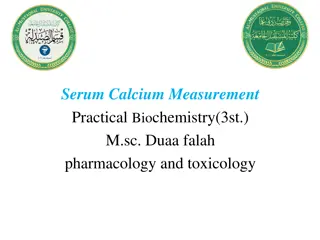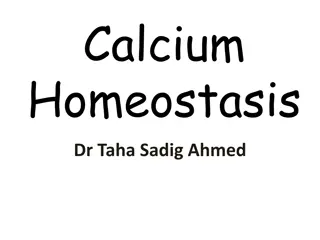Techno-Economic Analysis of Calcium Looping Processes for Low CO2 Emission Cement Plants
This study explores the application of Calcium Looping (CaL) processes in cement plants to reduce CO2 emissions. The process involves using CaO as a sorbent to capture CO2 from flue gas, with the potential for integration at different points in the cement production process. The Tail-end CaL configuration and Integrated CaL configuration are discussed, highlighting the benefits of using CaL for CO2 capture and its potential impact on cement plant operations.
Download Presentation

Please find below an Image/Link to download the presentation.
The content on the website is provided AS IS for your information and personal use only. It may not be sold, licensed, or shared on other websites without obtaining consent from the author.If you encounter any issues during the download, it is possible that the publisher has removed the file from their server.
You are allowed to download the files provided on this website for personal or commercial use, subject to the condition that they are used lawfully. All files are the property of their respective owners.
The content on the website is provided AS IS for your information and personal use only. It may not be sold, licensed, or shared on other websites without obtaining consent from the author.
E N D
Presentation Transcript
Techno-economic analysis of Calcium Looping processes for low CO2emission cement plants M. Spinelli, E. De Lena, M. Gatti, R. Scaccabarozzi, S. Campanari, S. Consonni, M.C. Romano Politecnico di Milano G. Cinti Italcementi 14thInternational Conference on Greenhouse Gas Control Technologies, GHGT-14 October 2018, Melbourne, Australia
SUMMARY Why Calcium-looping in cement plants Integration options of Calcium-looping in Cement plants Tail-end CaL configuration Integrated CaL configuration Key performance indicators Results Conclusions
WHY CALCIUM-LOOPING CO2-rich gas to sequestration CO2-lean flue gas CARBONATION CALCINATION CaCO3 O2 CaO+CO2 CaCO3 CaCO3 CaO+CO2 Heat fuel ~ 650 C ~ 900 C CaO CaO purge CaCO3 make-up Flue gas (CO2) Sorbent originates from CaCO3which is a raw material for clinker production CaO purge can be used in clinker production
TAIL-END CAL CONFIGURATION Carbonator removes CO2from cement plant flue gas highly suitable for retrofit CO2to CPU CO2depleted flue gas CaO-rich purge from CaL calciner used as feed for the cement kiln CFB CaL reactors: d50=100-250 m Particles for clinker production d50=10-20 m CaL purge milled in the raw mill at low temperature Carbonator CaCO3 Raw meal Calciner CEMENT kiln Flue gas fuel CaO O2 clinker
FLUIDIZED BED CARBONATOR FOR TAIL-END CAL CONFIGURATION Fluidized bed CaL process for cement plants demonstrated at CSIC and University of Stuttgart up to TRL6 The CaL design parameters for cement plant applications are in good agreement with the design parameters for power plant operation. Arias et al., 2017. CO2Capture by CaL at Relevant Conditions for Cement Plants: Experimental Testing in a 30 kW Pilot Plant. Ind. Eng. Chem. Res., 56, 2634 2640. Hornberger et al., 2017. CaL for CO2Capture in Cement Plants Pilot Scale Test. Energy Procedia, 114, 6171 6174.
INTEGRATED CAL CONFIGURATION CaL carbonator integrated in the preheater, treats the rotary kiln gas only CO2-lean flue gas Fresh raw meal CO2-rich gas to CPU Fresh raw meal Carbonator CaL calciner coincides with the cement kiln pre- calciner Raw meal preheater Raw meal preheater II CO2 recycle Calcined raw meal as CO2sorbent in the carbonator Calcined raw meal to carbonator Raw meal recycle Sorbent has small particle size (d50=10-20 m) entrained flow reactors Calciner Fresh raw meal Raw meal preheater III III Air Fuel Calcined raw meal to rotary kiln Rotary kiln Fuel Recarbonated / fresh sorbent to calciner O2
ENTRAINED FLOW CARBONATOR FOR INTEGRATED CAL CONFIGURATION 1D carbonator modelling showed possibility of achieving high capture efficiency with solids/gas ratio of ~10 kg/Nm3. Belite formation in calciner may cause a decrease of the sorbent CO2carrying capacity controlled calcination conditions needed. Demonstration of chemistry and fluid-dynamics of the reactors in industrially relevant conditions needed Visit the Cleanker poster! Spinelli et al., 2018. One-dimensional model of entrained-flow carbonator for CO2capture in cement kilns by calcium looping process. Chemical Engineering Science, 191, 100-114. Alonso et al., 2018. Capacities of Cement Raw Meals in Calcium Looping Systems. Energy & Fuels, 31, 13955 13962.
HEAT RECOVERY STEAM CYCLE CaL process involves additional fuel consumption. Excess heat recovered at high temperature by steam cycle. The resulting steam cycle size is: ~70 MWein the tail-end case ~20 MWein the integrated case Integrated CaL steam cycle SH EVA III Air Cooler (EVA) III Air Cooler (SH) Steam Turbine EVA Steam cycle parameters: 60-100 bar 460-530 C Steam turbine is=76-86% 1-2 feed water heaters Steam cycle electric efficiency = 30-36% CO2-rich gases HT Cooler 1 Deaerator ASU TSA heater Condenser EVA CPU TSA heater Cooling Tower Lean-CO2 gases HT Cooler LT ECO HT ECOs HT ECOs HT ECOs CO2-rich gases LT Cooler Condensate Pump Feedwater Pump III Air Cooler (ECO) Decarb gases HT Cooler CO2-rich gases HT Cooler 2
KEY PERFORMANCE INDICATORS MJ P Equivalent primary energy consumption: = + q q el eq t , ref el ker clin Indirect fuel consumption ( ref,el = 45.9%) Direct fuel consumption kg = + Equivalent CO2emissions: 2 CO e e P e , 2 2 , CO eq CO el ref el t ker clin Direct emissions Indirect emissions (eref,el=262 kg/MWh) Specific primary energy consumption: Equivalent fuel consumption of reference cement plant without capture q q , eq eq ref e = SPECCA e , 2 , , 2 CO eq ref CO eq Equivalent emissions of reference cement plant without capture
RESULTS: MASS AND ENERGY BALANCE Cement plant w/o capture Tail-end CaL (20% integration) Tail-end CaL (50% integration) Integrated CaL Carbonator CO2capture efficiency [%] Total fuel consumption [MJLHV/tclk] Rotary kiln fuel consumption [MJLHV/tclk] -- 88.8 8720 1220 90.0 7100 1220 82.0 5440 1150 3240 1230 Pre-calciner fuel consumpt. [MJLHV/tclk] 2010 1550 850 4290 CaL calciner fuel consumpt. [MJLHV/tclk] ASU electric consumption [kWh/tcem] CPU electric consumption [kWh/tcem] Steam turbine production [kWh/tcem] Other auxiliaries consumption [kWh/tcem] Net electricity consumpt. [kWhel/ tcem] Direct CO2emissions [kgCO2/tclk] Indirect CO2emissions [kgCO2/tclk] Equivalent CO2emissions [kgCO2/tclk] Equivalent CO2avoided [%] SPECCA [MJLHV/kgCO2] -- -- -- -- 97 97 865 35 900 -- -- 5950 85 110 413 137 -81 119 -29 90 90.0 4.42 5040 73 101 260 128 42 79 15 94 89.5 4.07 62 89 150 116 117 55 46 101 88.8 3.16 De Lena et al., 2017. Process integration of tail-end CaL in cement plants. Int J Greenh Gas Control. 67, 71-92.
RESULTS: ECONOMIC ANALYSIS Cost of CO2avoided mainly associated to Capex: Total CCA Fuel Electricity Other var. Opex Fixed Opex Capex 80 Integrated CaL Tail End CaL (IL=20%) Tail End CaL (IL=50%) 70 60 Cost of CO2avoided, /tCO2 50 40 30 20 10 0 -10 -20 -30 De Lena et al. Techno-economic analysis of Calcium Looping processes for low CO2emission cement plants. Submitted to Int J Greenh Gas Cont.
RESULTS: ECONOMIC ANALYSIS Cost of cement vs. Carbon tax: Cement kiln w/o CCS Tail End CaL IL 20 Tail End CaL IL 50 Integrated CaL 120 Integrated CaL plant 100 80 COC [ /tcem] Tail-end CaL plant 60 40 Cement kiln w/o capture 20 0 0 10 20 30 40 50 60 70 Carbon Tax [ /tCO2] De Lena et al. Techno-economic analysis of Calcium Looping processes for low CO2emission cement plants. Submitted to Int J Greenh Gas Cont.
CONCLUSIONS Ca-LOOPING PROCESS INTEGRATION OPTIONS: 1. Post-combustion capture configuration: Low uncertainty in the technical feasibility Very high CO2capture expected Two calciners are present in the system, leading to high fuel consumptions 2. Integrated CaL configuration: High CO2capture efficiency without modifying rotary kiln operation (no need of kiln oxyfiring). Higher thermal efficiency and lower fuel consumptions New carbonator design and fluid-dynamic regime: fluid-dynamics, heat management and sorbent performance need validation Competitive cost of CO2avoided. We have ideas on how to reduce Capex and Opex of the integrated CaL system to be explored in Cleanker project
Thank you Contact: matteo.romano@polimi.it www.gecos.polimi.it This project has received funding from the European Union's Horizon 2020 research and innovation programme under grant agreement no 641185. https://www.sintef.no/projectweb/cemcap/
